In this session, we invited some incredible guests to take the stage. Matt Holleran, Founder of Cloud Apps Capital Partners, introduces Jessica Mah, CEO of inDinero, and Ariel Poler, a prolific angel investor who founded IPRO and Topica.
Led by Ariel, an investor in inDinero, the talk delves into various subjects that many SaaS founders and CEOs concern themselves with on a daily basis. True to her signature style, Jessica speaks candidly about inDinero’s rocky journey from YC in Summer 2010 to hitting her stride and growing from 20 to 200 employees in the past 2 years.
Jessica shares how she’s successfully challenged the belief that software companies that offer a heavy service component are a bad idea. She also shares her struggles with rapidly growing and managing a distributed team, advice on qualifying candidates and recruiting top talent, as well as the power of PR (if you do it right).
Ariel adds his perspectives as an investor to each of Jessica’s learnings. The combined perspective of founder and investor who’ve worked together for years proves to be a great dynamic that we’ll be doing more of in coming years.
If you want to see more sessions from 2016, we’re releasing a new one each week. Subscribe here to be notified. And be sure to grab your tickets to the 2017 Annual NOW.
TRANSCRIPT
Matt Holleran: Matt Holleran, Cloud Apps Capital Partners. It is my pleasure to introduce Jessica Mah, the Founder and CEO of inDinero.
Jessica Mah: Thanks.
Matt: I’ve had the pleasure of knowing Jessica for a number of years and really pleased to see the business that she’s building, as well as Ariel Poler who’s an angel investor as well as an entrepreneur and a veteran in Silicon Valley. I’ll let them take the stage.
Jessica: Hey, how are you?
Matt: Very nice to see you.
Jessica: Good to see you.
Matt: Ariel.
Ariel Poler: Hi. Thank you.
Matt: Nice to see you.
[cheering]
Jessica: Oh yeah, hey guys. Hey everyone.
[applause]
Jessica: It’s really cool to be here actually because I was here at SaaStr a year ago and it wasn’t quite as cool as this.
Ariel: Yeah, I know. This is pretty cool. Actually, I was remembering this is the building where I became a US citizen, like 15 years ago.
Jessica: Wow.
Ariel: Yeah, pretty cool. I figure we could start maybe with the business and the time we met. When I first met you, I didn’t like the business. Actually, I didn’t like you that much either.
[laughter]
Ariel: What changed? What did you do, so that a few years later when I came back, then I did get involved with it?
Jessica: We could tell a short story. I’m Jessica Mah, founder and CEO of inDinero. We do accounting and tax for businesses. We give the software and we give the service, to take care of all of the finances, all the back office, for a company.
We started in 2010, I was going around pitching the service to investors. I was fresh out of college and Ariel was on my list of investors to pitch and he wasn’t interested right away, I could tell, but we got him on board three years later.
We started off as a mint.com for businesses. We thought, we’ll make it really easy for you to show your business financials online in real time, but it wasn’t actually a great idea. It was really, actually, a horrible idea, I thought, because business owners have a lot going on.
They’re lazy. They don’t want to look at their accounting. So that didn’t work out. We shut that down. We pivoted and now we’re full service, accounting and taxes. That’s when Ariel came on board.
Ariel: There’s a really interesting point there which is, here we are at a SaaS conference and I bet the majority of the companies are fully automated without too many people in the back end, but can you talk a little bit about how many employees you have, providing…
From the customer’s standpoint, it’s a computer but what’s behind that? It’s not your classical SaaS business.
Jessica: Yes, we have a really interesting business in that we have a lot of employees for being a relatively early stage start up. The challenge there is that when we first started the business and when we were pitching to investors, they were like, “I’m not sure if I like you guys because you have such a heavy service component.”
And, “I’m not sure how this is going to scale. You guys are probably better than a consultancy.” That was the big concern that everyone had. We even had this, we talked about this in the early days.
For me, I didn’t really have much of a choice. I thought, “All right, this is thesis of the business. Somehow, we’ll figure out a way to scale it by automating better over time, but that wasn’t really certain upfront. Of the 200 employees, maybe 80 of them are working on directly servicing our customers. It’s a lot of people doing that work.
We’re happy about it. We had this weird identity crisis for a while. We’re like, “Are we a software business? A service business?” For our investors’ sake, we had to say, “We’re a software business,” like screw the services. I would say that out of my own hands.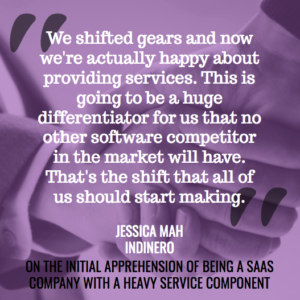
All my employees would be like, “Are you kidding me? I’m working at a software company, and you guys don’t even recognize my contributions?” “I’m making customers successful, I’m making them happy, and you guys don’t even care about us as service people.”
I shifted gears, and now, I’m trying to really say, “Look, actually we’re happy about providing services,” and this is something that we’re going to be proud about. This is going to be a huge differentiator for us that no other software competitor in the market will be able to have. That’s the shift that all of us should start making, as well.
Ariel: For me, one of the key takeaways was that providing a solution to the customer needs to be the top priority. Even more important than what are the margins and the economics, because once you have that, it’s easier to work around that, as opposed to, you may have great economics, but if the customers are not happy, then you’re not going to get very far.
Jessica: That’s absolutely right. When we first started the business, we were just software. We had no services, and we were so anti-services. I come from a computer science background. I’ve been programming my entire life. Services were the last thing I wanted to do.
I visited my customers, I went to their office, and I watched them use the service. They’re saying, “I would pay you guys so much more money if you just fixed my accounting problem for me. If you not just gave me the software, but you gave me a certified accountant to work on this, and just give me what I needed, at the end of the day, you would be worth a hundred times more money.”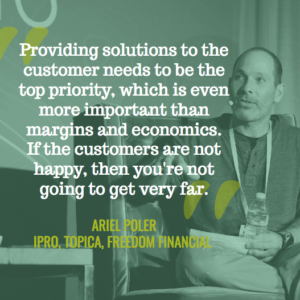
Ariel: The beauty is, your margins are pretty good. It’s not like you ended up in a situation where you have a great product, but a crappy business. It’s a healthy business.
Jessica: Yeah. We have Salesforce and a Hubspot level margins, we’re quite efficient, but it wasn’t that way when we first started. The thesis was, “We’re just going to bite the bullet, we’re going to be having services for a while. We’re going to fake it till you make it, and tell our investors and our customers, ‘Look, we’ll just have to get better at automation along the way.'”
We’re still not perfect. We still got such a far way to go.
But yeah, from a business perspective, we’re able to scale, so we’re capped on sales ability, not service capacity right now. Our gross margins are at the Salesforce and Hubspot level.
Ariel: We were talking before about things you would do different, mistakes, etc. One of the areas that came up was quality of execution versus speed and versus how fast you grow. I don’t know if you can talk a little about that, particularly in Silicon Valley, this “Grow, grow, grow” mentality and to what extent you’ve been riding that wave or not.
Jessica: As a first time founder, I have definitely made a lot of mistakes on this. At SaaStr, too, I had a lot of stress when I came to SaaStr last year because everyone here is trying to grow like 5x a year, right?
All of you guys are talking to each other and you’re thinking, “How do I grow faster?” I remember feeling really incompetent. I felt like I was not going fast enough. After the last SaaStr that’s how I felt. Because everyone else was killing it, right?
Ariel: Crushing it.
[laughter]
Jessica: Everyone was crushing it. I certainly wasn’t. I’m like, “2x, 3x? I’d be happy with that.” We talked recently at our last board meeting and the feedback that they gave us was, “Why do you have to grow that much? Is it about the business or is it about your ego?”
I really thought about that over Christmas holiday. A lot of that was around what I wanted. That’s something that I think I still struggle with and I think all of us probably struggle with here. There’s just a lot of pressure to grow.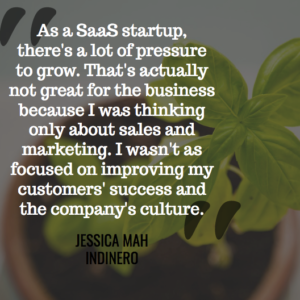
That’s actually not great for the business, because I was thinking only about sales and marketing. I wasn’t as focused on improving my customers’ success, on improving my culture. I need 200 people, right? We really have to care about training and culture more than any of our SaaS peers because we’re bringing on dozens of people every single month to the company.
Now I’ve got a full time professor. All he does is facilitate training at my company. I’ve got a small group of people who actually make sure that we have a great culture. That’s stuff that I wasn’t thinking about as much even three months ago.
Ariel: The recruiting and culture, that’s one of the areas that you’ve mentioned has been where you’ve evolved the most. Maybe you can talk about in the recruiting front. How has that changed, say, from a couple years?
Jessica: I feel like I’ve gotten way better at recruiting. When you hire so many people I feel like our experience is better. We could look at candidates and just pick out the better people right away. We have seven full-time internal recruiters now.
That’s something that I didn’t do early on enough. We had one full-time recruiter, but we were still always capped on how many people we could hire. That takes up all of our time as founders. I’ve heard some people here say that takes up 50 percent of their time, or more.
When we have good recruiters in place, they’re doing a lot of the interviewing. They’re doing all the sourcing. What I started doing just in the past two quarters is now we’re listing out, “Here are the top criteria for the people we want. Here are the questions that we’re going to use to evaluate them against. Here are the projects we’re going to make every sales rep go through.”
We don’t just interview a sales rep. We make them do mock phone calls. I’ve had them call low-quality leads to evaluate them, same with customer success people. We interview our engineers this way. So why don’t we do this for salespeople and for customer success people?
We’re a lot more methodical about that now than we were six months ago, even.
Ariel: The other related point you were telling me about is, in terms of when you need to upgrade the team I don’t know if that’s the right word, but when somebody’s not scaling or you need to bring additional experience, and making sure that people get enough of a heads up, that there’s planning around that as opposed to people being surprised?
Jessica: Yeah, we’ve been way too reactive over the past two years. When we were at two people, just me and my co-founder in our bedroom, we could say, “All right. We’re going to hire these five people, and then everything will be OK.”
Who here has thought, “All right, once I hire these five people, I’ll be so much happier?” You fill those five roles, and then you’re still unhappy, because now you’re worrying about the next hires.
That’s where we were. I keep a diary every day and I would write this. I went back and I read the past five years and I always wrote, “Aw, man, I’ll be so much happier next quarter once I fill these three positions.” That’s never the case.
Now, what we do is I’ve got like this, we call it the hiring model, and it maps out all the sales hires we’re making, all the revenue growth in the company. Based on how many sales reps we have that are upramped, that will inform how many customer service people we need, how many account managers we need, how many accountants we need, how many tax people we need, etc.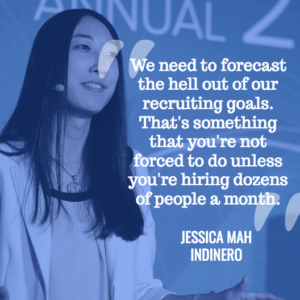
It just pops it out in the model, and I could give that to my recruiting team 90 days in advance because that’s how long it takes to fill a role with a really high-quality person. We need to make recruiting a lot more number spaced. We need to forecast the hell out of our recruiting goals, and that’s something that you’re not forced to do unless you’re hiring dozens of people a month.
Ariel: The other aspect that becomes really important when you’re hiring so many people, and when you have a, like in the case of inDinero, distributed workforce is culture. Can you touch on maybe some of the things that you do to define, nurture, and keep the culture?
Jessica: Yeah. We take so much inspiration from Zappos, and from HubSpot, and all those other companies from a cultural perspective. Like core values are number one for us. I don’t know if you guys have well defined core values out, but that’s a big deal for us.
We interview based on the core values. We do a lot of training upfront for it, and actually all of our new employees, they spend a lot of time watching our online training videos before their first day of work, so they’re all upramped on what the culture is going to be like, and how the company is going to function ahead of time.
We could talk for hours about culture, and it’s something we’re still working on. We’ve had a lot of people who weren’t fitting in with our culture, and there are some things that…like we’ve just added a new core value. Like radical candor. That’s a big deal for us now, and we didn’t care about that earlier in the company.
Also KPI focus. That’s a big part of our culture now. All of our sales reps, all of account managers, all of our customers service reps, they have a personal dashboard that they look at every single day that tells them how well they’re doing, and whether or not they’re in the red, yellow, or green.
That’s something that they swear by, and absolutely love, but that only came into our culture in the past quarter or two because it’s been getting impossible to manage all these people.
Ariel: You were telling me how KPIs is something you wish you would have done sooner. Any particular ones that you think are really key to do? Like if you could pick a few, “Oh, I wish I was doing this or that KPI from day one,” what would they be?
Jessica: It’s easy to pick KPIs. We want salespeople to close deals, we want customer success people to retain customers, and upsell customers. The harder part isn’t picking the KPIs.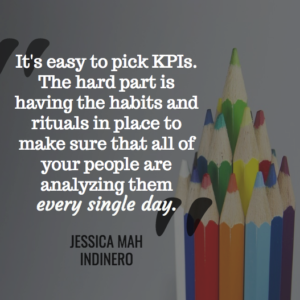
It’s like it’s having the habits in place to make sure that all of our people are looking at these KPIs every single day to make sure that they’re motivated, to make them better by tying their compensation to those KPIs, and making that part of the team culture where we review that as a team every single week, every single month.
Those habits and rituals only came into the company when we crossed the 130 employee mark. It’s more the rituals that matter.
Ariel: By the way, we’ll have a little bit of time at the end for questions, but in the meantime, if anybody wants to chime in, a question, a comment, I’ll try to…it’s harder because the lights are, but don’t necessarily wait until the end.
As an investor, one thing I’m always interested in is working with investors where you…Oh wait, is that a question there? Yeah, go for it, although I think maybe somebody can get a…it’s always great when the audience participates, and give us time to…
Jessica: By the way, if any of you guys are raising money, call Ariel. He’s one of my favorite investors ever.
Ariel: I like that.
Jessica: You could tell him any of your dirty laundry, and he won’t throw you out of the room.
Ariel: Go ahead.
Jessica: Go for it.
Audience Member: How did you know when to bring in your first in-house recruiter, and what were the key skills you were looking for in that first person?
Jessica: I actually misfired on my first recruiter. The question is when to bring in your first recruiter, and what to look for in the first recruiter. For us, we looked for just someone who had a lot of hustle, and they were too junior.
I wish I hired someone with corporate recruiting experience. Not just someone who worked at a recruiting agency because these recruiters go from agency to corporate, and you want someone who’s already been in the corporate atmosphere for a while. Now, all of our recruiters come from corporate recruiting environments.
I brought that person in as employee number seven. Next time I start a company, if I ever start another company again, I’m going to hire like an assistant and a recruiter. Those are like my first two hires.
Ariel: Yeah. No, I second that. Was that…? Yeah. There you go.
Audience Member: Hey, how are you doing?
Jessica: Hey.
Audience Member: Your employee base, are they all together, or are they dispersed around?
Jessica: The question is are our employees all together, or are they dispersed around? They’re dispersed around five different offices, so that means that it’s way harder to get everyone to communicate effectively together.
Audience Member: What are the communication challenges you’ve been having with dispersed teams, and what techniques have you adopted to help enhance that experience between the teams?
Jessica: That’s a good question. Again, like how are we enhancing the communication across multiple offices? I think that there are a few things. One, like we do the conference calls where everyone is on the GoToMeeting, and you see each other on the webcam.
We do that team by team every week, so they all have that team feel. The Slack group channels, or HipChat group channels help a lot with that. We don’t have too much difficulty now. People are actually pretty happy with the collaboration, but we had multiple locations from a very like early phase of our company, and we had people working from home early on, too.
We were used to that, and that was baked into our DNA.
Ariel: One thing I’ve seen is that when organizations have distributed people in multiple places, and a significant enough percentage of the team is distributed, it’s a lot easier than when almost the whole organization is in one place, and then you have very few people remote, because then they feel more left out.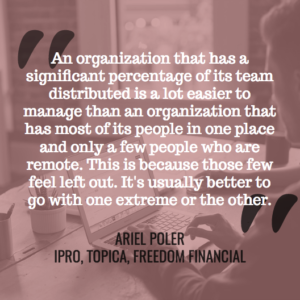
I tend to say go one extreme or the other, but be careful about just having very few people because technology helps, but that makes it a little harder. Yeah, go ahead.
Audience Member: Hi. Assuming the same product mix, and the same markets you’re going after now, how many employees will you have in 24 months from now?
Jessica: That’s a really good question. Probably north of 500, and I really don’t want that. We’re really trying to trim down our need for more people, and to make things more efficient, and there’s so many ways to do that.
Like I look at my model, and it pumps out how many people I’m going to have at the end of each quarter. We talk about it, and we think, “Oh, this is really not great,” because more people, more problems.
How could we make it so that salespeople could sell to fewer customers, and get the same numbers? How could we make it so that customer service people could service more people, but it’s still the same small team? How could software automate more of these problems that customer service has to jump in on?
We’re getting a lot better at that. At the rate we’re going, it won’t be 500. It’ll be far less, but if you don’t fix anything, we’re going to have way too many people, and I’m not going to know what to do with myself.
Ariel: I tell you, managing a large organization well is a competitive advantage. One of the reasons I was comfortable with the inDinero model is something on the board of company called Freedom Financial which already has 1,000 employees, but they’re well managed. Replicating that, it’s not easy.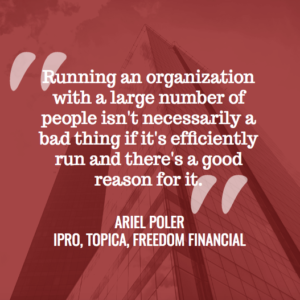
I don’t think it’s necessarily a bad thing if they’re efficiently run, and there’s a good reason, it’s not there for a bad reason. Is there someone there?
Jessica: Big question though.
Ariel: Yeah.
Audience Member: Hey.
Jessica: Hey.
Audience Member: For an individual dashboard, for customer success, what’s the number one metric that you track on a daily basis, and for an engineer, or developer, what’s the number one metric they track every day?
Jessica: What are the numbers that customer success tracks, and then what are the numbers that product/engineering team tracks? On customer success team, we care about customer satisfaction, so we’ve got green, yellow, red, and then what I think is the worst color which is blue.
Blue just means we don’t know how happy a customer is, and that number resets every 35 days. If you don’t touch the customer in 35 days as a customer success manager, then it’s going to turn blue, and that’s something that we didn’t do early on enough. We’ve really sucked at that.
Then also account management, we pay them 25 percent of their overall pay, is commission, and that’s based on the premise that they’re upselling more customers than they’re turning out.
If we don’t have a hundred percent in that revenue retention, account management gets none of their bonus, none of their commission, and I think that really aligns everyone really well. On the product team, it’s just like product engagement, and how well people are using a certain feature that that engineer is building.
Ariel: I was going to ask you, you have a lot of investors. What has worked well for you to get value out of investors for those in the audience who have investors?
Jessica: We have like probably over a hundred different investors. We did the massive party round, and I remember back in 2010 and ’11, all the advice given was no party ramps. Just pick like two VCs, and call it a day.
That was the advice, but for us, or for me, I don’t really care what the prevailing wisdom is. I like to just think about it myself, and decide what’s best for me. For inDinero, we thought that we wanted to have a wide variety of mentors because I couldn’t tell who would be the most helpful.
When we started working together, I had no idea if you’d be the most helpful person, or someone I wanted talked to more than once a year. By having the party model, that helps a first time entrepreneur better understand what they want. How do we get value from it?
Ariel: At the end of the day, out of those large number of investors, you end up leveraging a small percentage, but that’s OK because you found the ones that work. Is that part of the thinking?
Jessica: Yeah. That’s completely right. We only really talk closely with five of those 100 plus people, and then those people. I might text or call depending on what kind of problem I have. With Ariel, sometimes, I’ll just text him randomly, “Hey, do you have 10 minutes today to talk about a problem?” That’s kind of my way of working with people.
Ariel: Yeah. No, that makes sense. I don’t know…Oh, yeah. Go ahead.
Audience Member: Hey. I want to say, first of all, you do a fantastic job of targeting me on your advertising, so woo hoo.
Jessica: All right. That’s good. Why haven’t you signed up though? I’m just kidding.
Audience Member: That’s a great question. I don’t really understand how your organization is structured, because I’m not inside your organization. Obviously, the conversation started off earlier about professional services revenue, and scalability of that, and how does that affect margins which I think traditionally, people think about professional services revenue as supporting a higher margin part of the business.
Tomasz Tunguz talks about, and I think he’s going to be speaking in this conference, but what he talks about on his blog is this idea of pod scaling. Reducing that exponential growth to sort of linear growth where you think about what fractional number of sales, clients, success, implementation, etc., does it take to stand up a new client?
I’m wondering, how have you scaled, and do you think in terms of that, do you have a different framework for thinking? How do you scale your organization, and make sure that it stays balanced, because that’s an incredibly challenging problem?
Jessica: That’s a really good question. Tom is a VC at Redpoint, and he’s got a phenomenal blog. You should all read it, and I’ve been following his stuff for the past five years. I love his material, and we basically copy that.
We said, “All right. Here is a pod, a bucket of say 200 of our customers, and for 200 customers, how many account managers, and customer service people, and other onboarding implementation specialists are we going to need in order to provide work for those clients?” That also gets popped out of our hiring model.
“I know how many sales reps I want to hire. Based on that, I’m going to get X customers which means Y number of employees.” That’s exactly how we do it. There are ratios, and the goal for a company like us where we have high headcount needs, is how do we reduce that requirement to have so many people?
We’re looking at that basically every single month. Tomorrow, we’re just going to talk for an hour and a half on how we’re going to be able to trim down our efficiency better. It’s still an ongoing challenge. A great question though.
Ariel: There was a question over there.
Audience Member: Jessica, when you were going from 2010 to…I started reading about you I think in late 2013, 2014 when you started blowing up. I read about your friend, having problems with co-founders, and all of these issues.
What do you think attributed to your PR success, because the problem that you’re solving isn’t exactly like the most exciting problem to solve? Why do you think you saw so much success in the media?
Jessica: First of all, I actually think of accounting and tax, and financial management as being really compelling. It’s actually really interesting stuff. I think that’s the first part, and all of us could look at our business and think, “Oh man, this is so boring, and dull,” but it’s actually way cooler than that.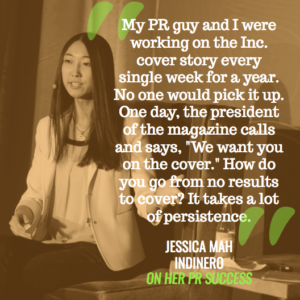
Two, I have a great PR guy who helps me out. A lot of props to him, and when looking for PR firms, I looked at a bunch of PR firms where you pay a lot of money. Then I evaluated a lot of PR freelancers, and contractors, so like a solo person who would work basically only for me, and they weren’t working for some big PR corporation.
That’s the key difference. I talk to my PR guy. I talked to him every week for over a year, and that’s what led up to some of our biggest hit stories. Like the Inc. Magazine cover, he and I were working on that story for a year, and no reporter would pick up that story.
He pitched to Inc. Magazine on it. None of the reporters liked it, and then one day, the president of Inc. Magazine calls, and says, “We want you on the cover.” How do you go from no results to cover? That’s just a lot of persistence, and talking to your PR guy every single week to come up with refining your story.
For that story, you mentioned co-founder problems. My co-founder and I actually don’t have problems. We’re best friends, and we live together. We’re not romantic, but we live together. We’re really good friends, and the story talked about marriage counseling.
We’ve been to marriage counseling like once or twice, but then they love the story so much. We went and got more marriage counseling, so we had more substance.
[laughter]
Ariel: Jessica, I’m curious. The great PR, what has it helped with the most? Is it about customers, is it about recruiting, is it about fundraising because in Silicon Valley, is often not about the customers. What has been the case for inDinero?
Jessica: For us, PR is really good for recruiting, and hiring. I thought it helped with customers a lot in the early days, and it still is helpful from a sales perspective, but it just brings talent in. That’s really the best thing.
Ariel: That’s been my experience as well. Is that a question there?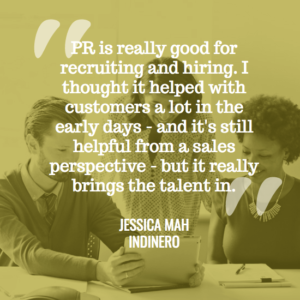
Audience Member: Yeah. We’re going to…
Ariel: No. Go head. Go ahead.
Audience Member: Hi, Jessica?
Jessica: Hey.
Audience Member: You spoke about recruiting. Can you give some tips on how to load the questions when you’re looking for a sales rep, or SDR account executive counselor?
Jessica: What kind of questions are putting in there or?
Audience Member: Yeah. How do you go about qualifying your sales reps, and hiring a good one?
Jessica: That’s a good question. Actually, what we looked for in a sales rep, day one, is completely different from what we look for today. Same with any role, I think we’re just better at attracting better talent today than ever before, and I think the key thing for us when we interview sales reps, it’s called the yoga pitch.
Basically, I want a prospective sales rep to pitch me on signing up for yoga. They cold call me, and then while they cold call my sales leadership, and tries to sell them on yoga, we pick that because we want to test their sales skills in something that everyone has equal knowledge about.
I don’t want them to pitch me on inDinero because I know where they’re going wrong. I don’t want them to pitch me on their own product, because anyone could pitch me on what they already know. That’s the key thing, and then we have a long list. I could send it to you if you ask me later.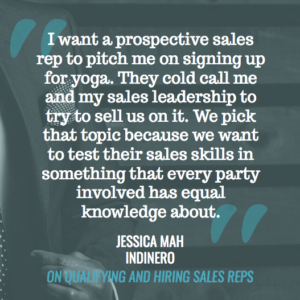
Ariel: I think we’re out of time, but I’m wondering if there’s any last thing. We’ve spoken about a lot of things in the past, but forward looking, what are you most excited about going forward?
Jessica: Yeah, sure. I’ll stay around in case you guys have more questions, but I’m really excited about just learning how to continue growing in the company. As we double and triple, and quadruple our head count, there are just so many more problems that come up that I’m forced to deal with now that I think it’s actually exciting.
Yeah, looks like it’s a pain in the ass, and it is a pain in the ass, but I love it anyway.
Ariel: That’s the thing that I really enjoy about working with you. This is a challenging business, but you seem to enjoy it. That’s the way to do it.
Jessica: Thank you.
Ariel: I think we’re out of time, so thank you all. Thank you for the questions.
[applause]
Jessica: Thanks.
Audience Member: All right.
[laughter]
